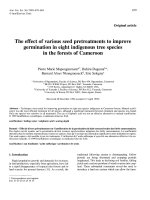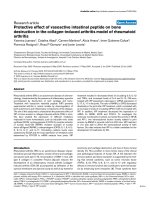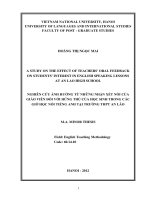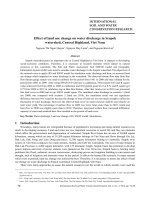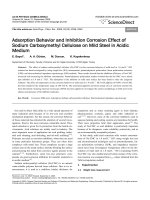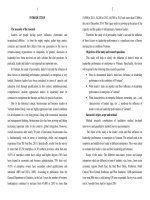Effect of various anti-mycoplasma drugs on haemato-biochemical changes in mycoplasma synoviae infected broilers
Bạn đang xem bản rút gọn của tài liệu. Xem và tải ngay bản đầy đủ của tài liệu tại đây (261.48 KB, 9 trang )
Int.J.Curr.Microbiol.App.Sci (2020) 9(8): 2092-2100
International Journal of Current Microbiology and Applied Sciences
ISSN: 2319-7706 Volume 9 Number 8 (2020)
Journal homepage:
Original Research Article
/>
Effect of Various Anti-mycoplasma Drugs on Haemato-biochemical
Changes in Mycoplasma synoviae Infected Broilers
Vijaykumar Matham1*, A. Gopala Reddy2, Prakash Nadoor1 and M. Ramakoti Reddy3
1
Department of Veterinary Pharmacology and Toxicology, Veterinary College,
KVAFSU, Bidar (KS)-585401, India
2
Department of Veterinary Pharmacology and Toxicology, PV Narasimha RaoTelangana
State Veterinary University, Hyderabad (TS)-500048, India
3
Division of Animal Health, ICAR Directorate of Poultry Research,
Hyderabad (TS)-500048, India
*Corresponding author
ABSTRACT
Keywords
Mycoplasma
synoviae, Broilers,
Haemoglobin, Total
protein, Albumin,
Globulin
Article Info
Accepted:
20 July 2020
Available Online:
10 August 2020
The present study was conducted to evaluate the effect of various antimycoplasma drugs
on haematological and biochemical changes in commercial broilers. Three hundred and
twenty, day-old, unsexed broiler chicks of Vencobb strain were randomly allotted to 7
treatment groups with each treatment having 4 replicates and each replicate consisting of
10 birds. T1 served as negative control, T2-T7 groups were administered with Tylosin,
Enrofloxacin, Taimulin, Erythromycin, Tilmicosin and Nizatidine whereas, T8 served as
positive control group. Blood samples were collected from all the treatment groups for the
estimation of haemato-biochemical profiles in mycoplasma affected broilers.
Haematological examination revealed a significant increase in red blood cells,
haemoglobin and packed cell volume in T7 group compared to T0. The AST levels in
group T1 were significantly (p<0.05) higher as compared to group T2 and T6 but were
significantly (p<0.05) lower at the end of 5th wk compared to T0. The ALT, ALP levels
were significantly (p<0.05) lower at the end of 5th week in all the groups. Total protein was
significantly (p<0.05) higher in T2 to T7 as compared to other groups at the end of 5 th wk.
All groups revealed significant (p<0.05) increase in albumin and globulin concentration on
5th week as compared to 3rd week. Thus, tylosin showed a significant restoration of
haemato-biochemical parameters in Mycoplasma broilers followed by enrofloxacin,
tiamulin, erythromycin, tilmicosin and nizatidine respectively.
Introduction
Mycoplasma synoviae (Ms), the smallest and
simplest bacteria, is categorized as an atypical
organism that lacks cell wall. It is a major
pathogen of chicken and turkey, and causes
respiratory tract infection and synovitis
worldwide. Most of the damage resulting
from Mycoplasma species infections in
humans and animals is due to the host
immune and inflammatory responses rather
than the direct deadly effects of Mycoplasma
2092
Int.J.Curr.Microbiol.App.Sci (2020) 9(8): 2092-2100
virulence factors. Different Ms strains are
characterized by differences in infectivity,
tissue tropism and pathogenicity. Stipkovits
(2000) has reported that- M. synoviae strains
are becoming more resistant to antibiotics
than other avian mycoplasmas, which means
that it is more difficult to treat infected flocks
successfully. Soon after antimicrobial drugs
have been readily available for human and
veterinary medicine usage, it was recognized
that decreased bacterial susceptibility could
adversely affect clinical outcome. This is no
less true for the mycoplasmas. Increasing
resistance
of
mycoplasmas
against
tetracyclines (TerLaak et al., 1993),
macrolides (Chirstensen et al., 1985) and
quinolones (Bebear et al., 1999) has been
reported both in animal and human species.
Antibiotics like tilmicosin and tylosin (Jordan
et al., 1996), oxytetracycline, amino
glycosides, lincosamides, fluoroquinolones
and tiamulin (Bradbury et al., 1994 and
Hannan et al., 1997) have been shown to
possess different degrees of in vitro activity
against various mycoplasma species. There is
a variety of antibacterials available in market,
but little data are available about its in vivo
efficacy against local isolates of Ms. Hence
the present study aimed to evaluate the antimycoplasmal efficacy of commercial drugs,
namely tylosin, enrofloxacin, taimulin,
erythromycin, tilmicosin and nizatidine,
against Mycoplasma synoviae (Ms) infection
in broiler chickens. Haemato-biochemical
parameters were assessed in this study
following the administration of these drugs to
the Ms-challenged birds.
Materials and Methods
Experimental birds and management
Three hundred and twenty (320), day-old,
unsexed broiler chicks of strain Vencobb were
purchased from a local hatchery for this study
and were randomly allotted to 8 treatment
groups with each treatment having 4
replicates and each replicate having 10 birds.
T1 served as negative control, T2-T7 groups
were
administered
with
Tylosin,
Enrofloxacin,
Taimulin,
Erythromycin,
Tilmicosin and Nizatidine whereas, T8 served
as positive control group (Table 1).
The brooder house as-well-as other equipment
were thoroughly disinfected before the arrival
of the chicks and maintained as per the Cobb
Broiler Management Guide (Cobb, 2008).
Additional source of heat was provided
during the brooding period. Birds of all the
groups were vaccinated with Marek’s Disease
Vaccine (Day 1) New castle disease (ND)
vaccine on 7th and 21st and 31st day and
infectious bursal disease (IBD) vaccine on
14th day. During the first three weeks of trial,
the chicks were fed adlibitum with standard
starter mashand thereafter with finisher mash.
Water at ambient temperature and diets
(starter and finisher phases) were supplied
adlibitum throughout the period (Table 2 and
3). All the birds from group T0-T7 were
inoculated with 104 ccu/ml of Ms Culture on
day 16.
Haemato-biochemical estimation
Around 5ml of blood samples were collected
from each replicate of birds at the end of 3rd
and 5thwk of the experimental period via
brachial vein for the estimation of Haematobiochemical parameters. In haematological
parameters, packed cell volume (%), red
blood cell count (106/mm3), MCH(Pg),
MCHC (%) and ESR (mm/h) were estimated
on 3rd and 5th week.
Sera samples were analyzed on 3rd and 5th
week for aspartate amino transferase, alanine
aminotransferase, alkaline phosphatase, total
proteinand albumin concentration using
diagnostic kits (Swamed).
2093
Int.J.Curr.Microbiol.App.Sci (2020) 9(8): 2092-2100
Results and Discussion
Hematological parameters
The haematological parameters recorded on
3rd and 5th week are depicted in (Table 4 and
5). Hematological data on 3rd week revealed
that birds in T7 group had significantly higher
number of circulating RBCs, packed cell
volume and haemoglobin concentration
(1.92±0.14,
31.95±0.19and
11.06±0.21)
followed by T2 group (1.82±0.21,
30.51±0.11, 12.85±0.12) as compared to as
compared to T0 (1.26±0.12, 26.25±0.09 and
10.15±0.10) group. Enrofloxacin still retains
the acceptable advantage because it has
broader spectrum of activity. On the contrary,
Amer et al., (2012) reported tilmicosin to be
effective in the treatment and prevention of
CRD in broilers derived from positive
breeders.
Enrofloxacin
is
antibiotics
belonging to the fluoroquinolone class of
compounds. This drug is more potent than
any earlier analogues, has a broad spectrum of
activity and drug resistant bacteria are
induced less frequently (Wolfson and Hooper,
1988).Non-significant
changes
in
the
haematological parameters of T1, T2, T3, T4,
T5, T6 and T7 group birds at the end of the
5thweek indicating a favorable response of the
treatment as opined by Ibrahim (2004) on
Mycoplasma synoviae infection.
Biochemical parameters
Mean ±SE of biochemical parameters on 3rd
and 5th week are presented in table 6 and 7.
The AST levels in the group T1 were
significantly (p<0.05) higher as compared to
group T2 and T6, but were significantly
(p<0.05) lower at the end of 5thwk compared
toT0. The activity of serum ALT (IU/L) in
groups T0 and T1 at end of 3rd week was
33.22±12.04 and 38.72±12.73, which was
significantly (P<0.05) higher compared to
other groups. The group T2 showed a
significant (P < 0.05) increase, as compared to
other groups at the end of 5thweek. AST is
associated with cell necrosis of many
different tissues, either muscular or hepatic
cells. It has both cytoplasmic and
mitochondrial isozymes and tends to be
released more than the ALT in chronic
hepatocellular diseases.
The ALT levels in the group T2 treated with
enrofloxacin were significantly (p<0.05)
higher as compared to group T0 and T7 but
were significantly (p<0.05) lower at the end
of 5th week compared to T6. Coles (1986)
reported that the increase in the serum activity
of ALT is directly related to the amount of the
damaged hepatocytes.
The activity of serum ALP (IU/L) in group T0
at end of 3rdweek was 2761±0.31, which was
significantly (P<0.05) increased in treated
groups. The ALP levels in the group T4 were
significantly (p<0.05) higher as compared to
groups T1 and T2, but were significantly
(p<0.05) lower at the end of 5th week as
compared toT0. The serum alkaline
phosphatase activity was increased five to six
time than the normal with hepatic diseases
(Coles, 1986). In the present study, the
therapeutic dose of enrofloxacin induced a
significant increase in the activities of the
AST, ALT and ALP at different weeks of age.
The findings are attributed to a mild toxic
effect of the drug metabolites, which increase
the permeability of the cell membrane
increasing hepatic enzymes. M. synoviae
infection induced highly significant increase
in AST and ALT in T0 group. The elevation
of serum enzymes may be due to the
increased cell membrane permeability and
destruction besides necrosis of hepatic cells
permitting the intracellular enzymes to escape
to the extracellular compartment then to
blood. Similar findings were also reported by
El-Shabiny et al., (1984), Ramadan (1996)
and Eisa (2001). A significant increase in the
2094
Int.J.Curr.Microbiol.App.Sci (2020) 9(8): 2092-2100
serum ALP in different groups at the 3rd and
5th week of age may be due to liver damage
associated with mild hepatitis or due to
increased activity of alkaline phosphatase in
the synovial fluid by Mycoplasma synoviae
infection resulting from alteration in capillary
permeability that occur during the bacterimic
phase of the disease as mentioned by ElShabiny (1984), Ramadan (1996) and Eisa
(2001). The findings are in agreement with
those previously recorded byIbrahim (2004)
who stated that the enrofloxacin caused
hepatic dysfunction. While at the end of the
5th week, the activities of these enzymes
nearly regained their normal values due to the
cessation of the drug. The results are in
accordance with those observed by Hillel
(1988), Ramadan (1996), Ibrahim (2004) and
El-Kadeem (2005), who reported that the
enrofloxacin induced an elevation of the
serum transaminase activities and AP during
treatment. This elevation nearly restored its
normal value after cessation of drug
metabolites.
Table.1 In vivo experimental protocol for pharmacological evaluation of drugs against Ms
S. No.
Group
Birds/
Group
40
1.
T0:Negativeco
ntrol
2.
T1:Treatment
40
3.
T2:Treatment
40
4.
T3:Treatment
40
5.
T4:Treatment
40
6.
T5:Treatment
40
7
T6:Treatment
40
8
T7:Postivecon
trol
40
Group treatment
Control group T0 was fed standard basal ration
without any antibiotic/herbal medicine added to it
(inoculated with Ms Culture on Day 16)
Tylosin dose @MIC value from Day 1-3;Day 1618;Day 26-28, and Day 34-36 inoculated with Ms
Culture on Day 16
Enrofloxacin dose @ MIC value; from Day 1 3;Day 16-18;Day 26-28, and Day 34-36
(inoculated with Ms Culture on Day 16)
Taimulin dose @ MIC value; from Day 1-3;Day 1618;Day 26-28, and Day 34-36
(inoculated with Ms Culture on Day 16)
Erythromycin dose @ MIC value; from Day 13;Day 16-18;Day 26-28, and Day 34-364
(inoculated with Ms Culture on Day 16)
Tilmicosin dose @MIC value; from Day 1-3;Day
16-18;Day 26-28, and Day 34-36
(inoculated with Ms Culture on Day 16)
Nizatidine@MIC value; from Day 1-3;Day 1618;Day 26-28, and Day 34-36
(inoculated with Ms Culture on Day 16)
Positive Control group was fed standard basal
ration without any antibiotic/herbal medicine
added to it (Not inoculated with Ms Culture on Day
16)
2095
Int.J.Curr.Microbiol.App.Sci (2020) 9(8): 2092-2100
Table.2 Composition of diets for broiler (starter and finisher phases)
Ingredients
Maize
Soybean meal
Groundnut cake
Fishmeal
Wheat offal
Bone meal
Oyster shell
Salt
Premix
Methionine
Lysine
Starter phase (%)
46.00
18.50
15.00
2.00
12.45
2.00
3.00
0.25
0.25
0.30
0.25
100
Finisher phase (%)
50.00
12.00
11.00
2.00
19.05
2.00
3.00
0.25
0.25
0.25
0.20
100
*1kg of premix contains:
Vitamin A-10,000,000 IU; Vitamin D3-2,000,000; Vitamin E-20,000 IU ;Vitamin K-2,250mg; Thiamine B11,750mg; Riboflavin B2- 5,000mg; Pyridoxine B6- 2,750mg; Niacin-27,500mg; Vitamin B12-15mg; Pantothenic
acid- 7,500mg; Folic acid-7500mg; Biotin-50mg; Choline chloride-400g; Antioxidant-125g; Magnesium-80g; Zinc50mg; Iron-20g; Copper-5g; Iodine-1.2g; Selenium-200mg; Cobalt-200mg
Table.3 Nutritional Values of Feed used in the experiment
Calculated
Starter phase
Crude protein(%)
M.E(Kcal/kg)
Etherextract(%)
Crude fibre(%)
Calcium(%)
Phosphorus(%)
23.05
2816
3.93
3.67
1.75
0.43
Finisher
phase
19.91
2809.6
3.89
3.79
1.74
0.41
Table.4 Effect of drug treatment on the hematological profiles in broiler chickens (3rd week)
T0
T1
T2
T3
T4
T5
T6
T7
RBC
PCV(%)
(x106/µL)
1.26±0.12a 26.25±0.09a
1.72±0.17 b 29.62±0.12b
1.82±0.21 b 30.51±0.11b
1.76±0.13 b 29.96±0.17b
1.32±0.14 a 31.04±0.19 ab
1.67±0.13 b 31.96±0.17b
1.70±0.17 b 27.62±0.12 a
1.92±0.14b 31.95±0.19 ab
Hb(g/dl)
MCV(fl)
MCH(Pg)
MCHC(%)
ESR(mm/h)
10.15±0.10 ab
12.40±0.17 ab
12.85±0.12 b
12.67±0.19 b
10.15±0.21 a
14.67±0.19 b
13.40±0.17 b
11.06±0.21 a
116.23±0.09 a
122.72±0.11 ab
120.98±0.08ab
126.68±0.12 b
116.23±0.07 a
128.68±0.12 b
112.72±0.11a
117.14±0.07 a
42.05±0.10a
52.81±0.17b
52.41±0.12b
54.41±0.11b
42.05±0.13 a
56.41±0.11b
48.81±0.17b
42.96±0.13 a
33.93±0.09a
42.46±0.17 b
42.85±0.11 b
42.81±0.13 b
33.93±0.11a
44.81±0.13 b
48.46±0.17 b
34.84±0.11a
1.32±0.11a
2.35±0.17 b
2.41±0.13 b
2.33±0.09 b
1.32±0.14 a
2.53±0.09 b
1.75±0.17a
2.23±0.14b
Means within a column with different subscripts differ significantly (p<0.05)
2096
Int.J.Curr.Microbiol.App.Sci (2020) 9(8): 2092-2100
Table.5 Effect of drug treatment on the hematological profiles in broiler chickens (5th week)
T0
T1
T2
T3
T4
T5
T6
T7
RBC
(x106/µL)
1.37±0.12a
2.27±0.21 b
2.17±0.17 b
2.21±0.13 b
1.46±0.14 a
2.12±0.13 b
2.15±0.17 b
1.46±0.14 a
PCV(%)
Hb(g/dl)
MCV(fl)
MCH(Pg)
32.4±0.09 ab
30.96±0.11a
30.07±0.12 a
30.41±0.17 a
31.49±0.19 ab
32.41±0.17 a
28.07±0.12 a
31.49±0.19 ab
11.51±0.10 a
13.3±0.12 b
12.85±0.17 b
13.12±0.19 b
10.6±0.21 a
15.12±0.19 b
13.85±0.17 b
10.6±0.21 a
117.59±0.09 a
121.43±0.08 b
123.17±0.11 b
127.13±0.12 b
116.68±0.07 a
129.13±0.12 b
113.17±0.11 a
116.68±0.07 a
43.41±0.10a
52.86±0.12b
53.26±0.17b
54.86±0.11b
42.5±0.13 a
56.86±0.11b
49.26±0.17b
42.5±0.13 a
MCHC(%) ESR(mm/h)
35.29±0.09a
43.3±0.11 b
42.91±0.17 b
43.26±0.13 b
34.38±0.11a
45.26±0.13 b
48.91±0.17 b
34.38±0.11a
2.68±0.11b
2.86±0.13 b
2.8±0.17 b
2.78±0.09 b
1.77±0.14 a
2.98±0.09 b
2.2±0.17 b
1.77±0.14 a
Means within a column with different subscripts differ significantly (p<0.05)
Table.6 Effect of drug treatment via water on biochemical profiles in broiler chickens (3rdweek)
Parameter
T0
T1
T2
T3
T4
T5
18.31±2.74b 23.46±2.07a 10.98±2.02b 13.19±2.19b 13.19±2.11b 14.71±3.33b
AST(U L-1)
33.22±12.04ab 38.72±12.73a 26.20±8.94b 19.97±7.69ab 19.97±7.69ab 20.22±13.19ab
ALT(U L-1)
1
2761±0.31 a 3149±0.22 b 3033±0.12 b 3407±0.27 b 3741.13±0.14 b 3033±0.12 b
ALP(U L- )
20.86±3.63b 22.263±2.00ab 20.59±2.71b 20.11±6.18b 19.19±3.37b 17.42±1.75b
Albumin
(mg/100ml)
31.73±8.10b 44.51±12.18ab 41.18±7.42ab 40.22±9.69a 38.37±6.78ab 34.84±8.63ab
Serum globulin
(mg/100ml)
52.59 ±9.31a 66.77 ±13.35a 61.72 ±8.74a 60.33 ±4.71a 57.56±9.02a 52.26±9.68a
Serum total
protein(mg/100
ml)
1.50
2.00
2.00
2.00
2.00
2.00
A:G ratio
Means within a row with different subscripts differ significantly (p<0.05)
T6
T7
21.82±2.84b 18.28±3.87ab
38.94±7.21a
24.2±7.57b
b
3407±0.27
2341.13±0.14a
a
21.33±4.53
21.54±2.70a
42.66±6.26a
43.08±5.80a
63.99 ±6.88ab
64.62±5.34a
2.00
2.00
Table.7 Effect of Drug Treatment via water on Biochemical profiles in
Broiler chickens (5th week)
Parameter
T0
T1
T2
T3
T4
28.63±3.74ab 33.78±3.07a
21.30±3.02b
23.51±2.90ab 23.51±2.90ab
AST(U L-1)
ab
a
b
1
43.45±2.04 48.95±2.73
16.20±8.94
30.20±7.69ab 30.20±7.69ab
ALT(U L- )
c
a
b
1
2690±0.23
2085.23±0.21 2185.23±0.26 2275.23±0.09 b 2481.29±0.19 c
ALP(U L- )
b
27.50±3.63 28.80±3.00ab 28.80±2.71b
26.79±6.18a
32.16±3.37ab
Albumin
(mg/100ml)
71.08±6.78ab
Serum globulin 50.77±8.10ab 63.65±12.18ab 53.65±7.42ab 59.22±9.69b
(mg/100ml)
78.27 ±9.31a 92.45 ±13.35a 82.45 ±8.74a 86.01 ±4.71a 103.24±9.02a
Serum total
protein
(mg/100ml)
1.85
2.21
1.86
2.21
2.21
A/G Ratio
Means within a row with different subscripts differ significantly (p<0.05)
2097
T5
T6
T7
25.03±4.33ab 32.14±2.84ab
30.45±3.19ab 49.17±7.21a
2185.23±0.26 b 2275.23±0.09 b
33.63±1.75ab 27.93±4.53ab
28.60±3.87ab
14.2±7.57b
2081.29±0.19 c
28.13±2.70a
74.31±8.63a
61.74±6.26ab
62.17±5.80a
107.94±9.68a
89.67 ±6.88a
90.3±5.34a
2.21
2.21
2.21
Int.J.Curr.Microbiol.App.Sci (2020) 9(8): 2092-2100
The concentration of total protein (mg/100ml)
of the group T0 was significantly (p<0.05)
lower (52.59 ±9.31 and 78.27 ±9.31 during 3rd
and 5thwk, respectively) than those of group
T7 (64.62±5.34 and 90.3±5.34 during 3rd and
5thwk, respectively). The concentration of
albumin (mg/100ml) of the group T0 was
significantly (p<0.05) lower (20.86±3.63 and
27.50±3.63 during 3rdand 5thwk, respectively)
than those of group T7 (21.54±2.70 and
28.13±2.70
during
3rd
and
5thwk,
respectively). The groups T3 to T6 showed
significant (p<0.05) increase in albumin
concentration as compared to group T0 at the
end of 5thwk. The concentration of globulins
(mg/100ml) of the group T0 was significantly
(p<0.05) lower (31.73±8.10 and 27.50±3.63
during 3rdand 5thwk, respectively) than those
of group T7 (21.54±2.70 and 50.77±8.10
during 3rd and 5thwk, respectively). The
groups 3 to 6 showed significant (p<0.05)
increase in globulin concentration as
compared to group T0 at the end of 5th wk.
The groups T3 to T7 showed significantly
(p<0.05) higher globulin concentration as
compared to group T2 at the end of 5th wk.
The values of groups T3 and T6 (40.22±9.69
and
42.66±6.26,
respectively)
were
comparable to that of group T7 at the end of
5th wk. The A/G ratio of T0 group was
significantly (p<0.05) lower (1.50± 0.13 and
1.85 ± 0.22 during 3rd and 5thwk, respectively)
than those of group T7 (2.00 ± 0.09 and 2.21
± 0.03 during 3rd and 5th wk, respectively). All
the treated groups (3 to 7) were comparable to
that of group T7 at the end of 3rd and 5thwk.
The chickens of all the groups showed
hyperglobulinaemia
which
led
to
hyperproteinaemia. The results are in
accordance
with
Eisa
(2001).
The
hyperglobulinaemia may be due to the
immunodefence of the chickens against the
microorganism.
Similar
results
were
described
by
Coles
(1986).
Hypoalbuminaemia was encountered at the
end of the 5th week only, it may be attributed
to inflammation and destruction in the liver,
which is the main source of albumin synthesis
in the body as previously mentioned. On the
other hand, Eisa (2001) recorded nonsignificant changes in the albumin in 10 day
old chickens, infected with Mycoplasma
synoviae. This result agrees with that obtained
in the 3rd week. M. synoviae infection did not
affect the renal tissues. The findings are in
agreement with Ramadan (1996) and Ibrahim
(2004). The present study showed that the
treated groups induced non-significant
changes in the total proteins, albumin and
globulin at the end of the 3rd and 5th weeks.
This result may be due to the mild and
reversible effect of the drug on the liver. The
results agree with those observed by Ibrahim
(2004). On the other hand, with reference to
group T2 our findings agree with Ibrahim
(2004) and El- Kadeem (2005). They
mentioned that the enrofloxacin induced
hypoproteinaemia, hypoalbuminaemia or
increase in the total proteins, albumin and
globulin. Non- significant change in albumin
in T1, T2 and T3 compared with T0 at the end
of the 5th week indicating a favorable
response to the treatment. Similar results were
previously obtained by Ibrahim (2004). The
used enrofloxacin in the present study
affected the renal tissue leading to some renal
damage which agrees with Wang et al.,
(2001). Thus, enrofloxacin showed the
significant
restoration
of
haematobiochemical parameters in Mycoplasma
broilers followed by tylosin, tiamulin,
erythromycin, tilmicosin and nizatidine.
References
Amer, M.M., Zohair, G.A., M. EL-Bayomi.
and Zeinab, M. S.2012. Effect of
Tilmicosin
in
Control
of
Mycoplasmosis in Broiler Chickens
from Infected Breeders Using Elisa Test
for Evaluation. Journal of American
2098
Int.J.Curr.Microbiol.App.Sci (2020) 9(8): 2092-2100
Science. 8(3): 696-700.
Bébéar, C. M., Renaudin, J. A., Charron, H.,
Renaudin, B., de Barbeyrac, T.,
Schaeverbeke. and Bébéar, C. 1999.
Mutations in the gyrA, parC and par E
genes associated with fluoroquinolones
resistance in clinical isolates of
Mycoplasma hominis. Antimicrobial
Agents Chemotherapy. 43: 954-956.
Bradbury, J.M., Yavari, C.A., Giles, C.J.
1994. In vitro evaluation of various
antimicrobial
against
mycoplasma
gallisepticum and mycoplasma synoviae
by the micro-broth method and
comparison with a commercially
prepared system. Avian Pathology. 23:
105-15.
Christensen, G. D., Simpson, W.A., Younger,
J. J., Baddour, L. M., Barrett, F. F.,
Melton, D. M. and Beachey, E.H. 1985.
Adherence
of
coagulase-negative
staphylococci to plastic tissue culture
plates: a quantitative model for the
adherence of staphylococci to medical
devices.
Journal
of
Clinical
Microbiology. 22: 996-1006.
Cobb-Vantress. 2008. Broiler management
guide.
Coles, E. H. 1986. Veterinary Clinical
Pathology. Edn. 4th., London, UK. WB
Saunders Company.
Eisa, A. M. A. 2001. Clinicopathological
studies on the effect of aivlosin as
antimycoplasmal drug in chickens. PhD
Thesis. Clinical Pathology Department.
Faculty of Veterinary Medicine, Zag
University.
El-Kadeem, A. E. M. 2005. Pharmacological
studies of gentamicin and ciprofloxacin
in collibacillosis in chickens. M.V.Sc.
Thesis, Pharmacology Department.
Faculty of Veterinary Medincine, Zag
University.
El-Shabiny, L. M. 1984. Serum proteins and
enzymatic changes in association with
Mycoplasma Synoviae infection in
poultry. Ph.D. Thesis, Biochemistry
Department. Faculty of Veterinary
Medicine. Zag University.
Hannan, P. T. C., Windsor, G.D., de Jong, A.,
Schmeer, N., Stegemann, M. 1997.
Comparative susceptibilities of various
animal-pathogenes mycoplasmas to
fluoroquinolones. Antimicrobial Agents
Chemotherapy. 41: 2037-40.
Hillel, H. 1988. Adverse effects of
fluoroquinolones. Reviews in Infectious
Diseases. 10: 258-261.
Ibrahim, M. A. K. 2004. Interaction between
danofloxacin and isoflurpredoneactetate
in
chickens.
M.V.Sc.
Thesis,
Pharmacology Dept. Faculty of
Veterinary Medicine, Zag. University.
Jordan, F.T.W. and Horrocks, B.K. 1996. The
minimum inhibitory concentration of
tilmicosin and tylosin for Mycoplasma
gallisepticum and Mycoplasma synoviae
and a comparison of their efficacy in the
control of Mycoplasma gallisepticum
infection in broiler chicks. Avian
Diseases. 40: 326-34.
Minion, F. C. and Kapke, P. A. 1998.
Transformation
of
mycoplasmas.
Methods in Molecular Biology-Clifton
Then Totowa. 104: 227-234.
Ramadan, O. E. 1996. Some pharmacological
studies on danofloxacin in chickens.
PhD Thesis, Pharmacology Department.
Faculty of Veterinary Medicine. Zag
University.
Stipkovits, L., Ripley, P. H., Varga, J. and
Palfi, V. 2000. Use of valnemulin in the
control of Mycoplasma bovis infection
under field conditions. Veterinary
Record. 148: 399–402.
TerLaak, E. A., Noordergraaf, J. H. and
Verschure, M. H. 1993. Susceptibilities
of Mycoplasma bovis, Mycoplasma
dispar and Ureaplasma diversum strains
to antimicrobial agents in vitro.
Antimicrobial Agents Chemotherapy.
37:317-321.
2099
Int.J.Curr.Microbiol.App.Sci (2020) 9(8): 2092-2100
Wang, C., Ewing, M. and A'arabi, S. Y. 2001.
In vitro susceptibility of avian
mycoplasmas
to
enrofloxacin,
sarafloxacin,
tylosin
and
oxytetracycline. Avian Disease.45: 456460
Wolfson, J.S., and Hooper, D.C. 1985. The
fluoroquinolones:
structures,
mechanisms of action and resistance,
and spectra of activity in vitro.
Antimicrobial. Agents Chemother.
28(4): 581-586.
Yalçin, S., Önenç, A., Özkan, S., Güler, H.C.
and Siegel, P. B. (2005). Meat quality
of heat stressed broilers: Effects of
thermal conditioning at pre- and postnatal stages. XVIIth Eur. Symp.
Qual. Poult. Meat. Doorwert, The
Netherlands. WPSA, Beekbergen, The
Netherlands.
How to cite this article:
Vijaykumar Matham, A. Gopala Reddy, Prakash Nadoor and Ramakoti Reddy, M. 2020. Effect
of Various Anti-mycoplasma Drugs on Haemato-biochemical Changes in Mycoplasma
synoviae Infected Broilers. Int.J.Curr.Microbiol.App.Sci. 9(08): 2092-2100.
doi: />
2100

